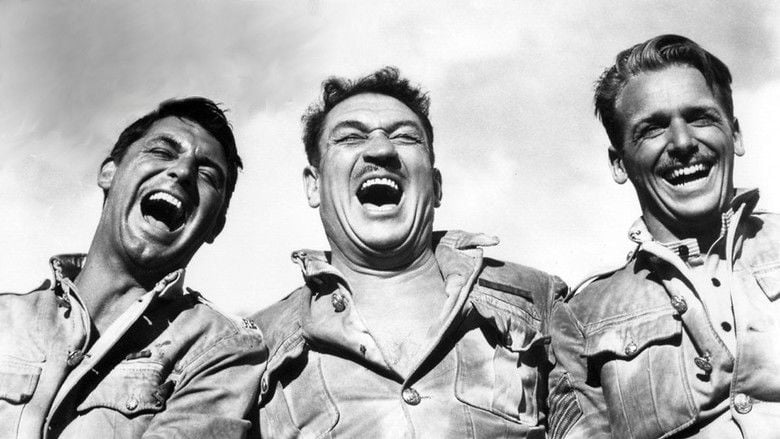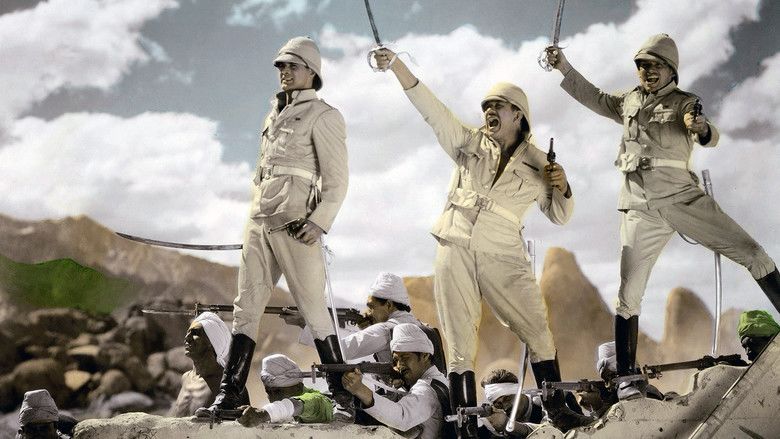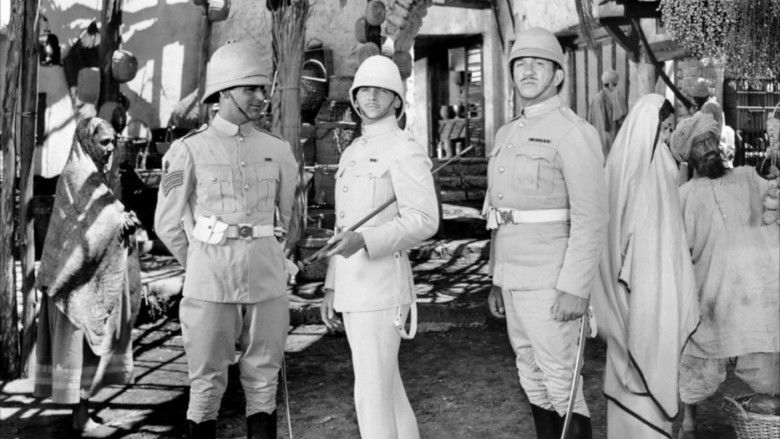Gunga Din (film)
8.5 /10 3 Votes8.4
92% Rotten Tomatoes Genre Adventure, War | 7.6/10 IMDb Adapted from Gunga Din Duration | |||||||||||||||||||||||||||||||||
 | ||||||||||||||||||||||||||||||||||
Release date February 17, 1939 (1939-02-17) (U.S.) Cast (Cutter), (MacChesney), Douglas Fairbanks Jr. (Ballantine), (Gunga Din), (Guru), (Emmy)Similar movies The Last Witch Hunter , Starship Troopers , Terminator Salvation , Star Wars: Episode II - Attack of the Clones , The Lord of the Rings: The Two Towers , The Hunger Games: Catching Fire Tagline Thrills for a thousand movies plundered for one mighty show!...The picture that sweeps the screen like a cyclone! | ||||||||||||||||||||||||||||||||||
Gunga din 1939 official trailer cary grant joan fontaine movie hd
Gunga Din is a 1939 RKO adventure film directed by George Stevens and starring Cary Grant, Victor McLaglen, and Douglas Fairbanks, Jr., loosely based on the poem of the same name by Rudyard Kipling combined with elements of his short story collection Soldiers Three. The film is about three British sergeants and Gunga Din, their native bhisti (water bearer), who fight the Thuggee, an Indian cult, in colonial British India.
Contents
- Gunga din 1939 official trailer cary grant joan fontaine movie hd
- Plot
- Development
- Shooting
- Box Office
- Critical
- Awards
- Influence
- References

The supporting cast features Joan Fontaine, Eduardo Ciannelli, and in the title role, Sam Jaffe. The epic film was written by Joel Sayre and Fred Guiol from a storyline by Ben Hecht and Charles MacArthur, with uncredited contributions by Lester Cohen, John Colton, William Faulkner, Vincent Lawrence, Dudley Nichols, and Anthony Veiller.

In 1999, Gunga Din was deemed "culturally significant" by the United States Library of Congress and selected for preservation in the National Film Registry.

Plot

On the Northwest Frontier of India, circa 1880, contact has been lost with a British outpost at Tantrapur in the midst of a telegraph message. Colonel Weed (Montagu Love) dispatches a detachment of 25 British Indian Army troops to investigate, led by three sergeants of the Royal Engineers, MacChesney (Victor McLaglen), Cutter (Cary Grant), and Ballantine (Douglas Fairbanks, Jr.), long-time friends and veteran campaigners. Although they are a disciplinary headache for their colonel, they are the right men to send on a dangerous mission. Accompanying the detail are six Indian camp workers, including regimental bhisti (water carrier) Gunga Din (Jaffe), who longs to throw off his lowly status and become a soldier of the Queen.

They find Tantrapur apparently deserted and set about repairing the telegraph. However, they are soon surrounded by hostile natives. The troops fight their way out. Colonel Weed and Major Mitchell (Lumsden Hare) identify an enemy weapon brought back as belonging to the Thuggee, a hostile indigenous group that had been suppressed for many years.

Ballantine is due to leave the army in a few days to wed Emmy Stebbins (Joan Fontaine) and go into the tea business, a combined calamity that MacChesney and Cutter consider worse than death. Meanwhile, Gunga Din tells Cutter of a temple he has found, one made of gold. Cutter is determined to make his fortune, but MacChesney will have none of it and has Cutter put in the stockade to prevent his desertion. That night, Cutter escapes with Din's help and goes to the temple, which is all that Din had claimed. Unfortunately, they discover that it belongs to the Thugs when the owners return. Cutter creates a distraction and allows himself to be captured so that Din can slip away and sound the warning.
When Din gives MacChesney the news, he decides to go to the rescue. Ballantine wants to go, too, but MacChesney points out that he cannot, as he is now a civilian. Ballantine reluctantly agrees to re-enlist, on the understanding that the enlistment paper will be torn up after the rescue. Emmy tries to dissuade him from going, but he refuses to desert his friends.
Due to miscommunication between Din and MacChesney, the trio foolishly enters the temple by themselves and are easily captured. They manage to free themselves and take the guru of the cultists (Eduardo Ciannelli) hostage on the roof of the temple. A standoff ensues.
When the regiment comes to the rescue, the guru boasts that they are marching into the trap he has set, with the three sergeants as bait. He orders his men to take their positions, but when he sees that they are unwilling to leave him in enemy hands, he leaps to his death in a pit full of cobras to remove that obstacle. Thugs then climb the temple and overwhelm the soldiers, and shoot and bayonet Cutter. Gunga Din is also bayoneted, but manages with the last of his strength to climb to the top of the gold dome of the temple and sound the alarm with a bugle taken from a dead Thug. He is then shot dead, but the British force is alerted and defeats the Thuggee forces. At Din's funeral pyre, the colonel formally inducts Gunga Din as a British corporal and reads the last lines of the Kipling poem over the body. (Some edited versions of the film omit the four italicised lines which presumably offended the American Hays code of censorship):
So I'll meet 'im later onAt the place where 'e is gone –Where it's always double drill and no canteen;'E'll be squattin' on the coalsGivin' drink to poor damned souls,An' I'll get a swig in hell from Gunga Din!Yes, Din! Din! Din!You Lazarushian-leather Gunga Din!Though I've belted you and flayed you,By the livin' Gawd that made you,You're a better man than I am, Gunga Din!The film ends with a final image of Gunga Din's spirit standing proudly and saluting at attention in British uniform.
Development
The rights to Kipling’s poem were bought by producer Edward Small's Reliance Pictures in 1936 in exchange for ₤4,700. RKO took the rights as part of a production deal with Small when he moved to the company. William Faulkner did some preliminary script work then the project was assigned to Howard Hawks. He got Ben Hecht and Charles MacArthur to write the screenplay and the film was set to start in 1937 but was delayed to find suitable cast. Hawks was fired from the project following the commercial failure of Bringing Up Baby and George Stevens was assigned to direct.
Originally, Grant and Fairbanks were assigned each other's role; Grant was to be the one leaving the army to marry Joan Fontaine's character, and Fairbanks the happy-go-lucky treasure hunter, since the character was identical to the legendary screen persona of Fairbanks' father.
According to Robert Osborne of Turner Classic Movies, when Grant wanted to switch parts, director George Stevens suggested they toss a coin; Grant won and Fairbanks, Jr. lost his most important role.
On the other hand, according to a biography of director George Stevens by Marilyn Ann Moss entitled Giant: George Stevens, a Life on Film, the Cutter role was originally slated for comedy actor Jack Oakie until Grant requested the part because it would enable him to inject more humor into his performance, at which point Fairbanks, Jr. was brought on board to replace Grant as Ballantine.
On a more recent showing of the film on TCM, Ben Mankiewicz has contradicted the story told about the coin-flip by his colleague Osbourne, and has stated that while Grant was originally slated to play Sergeant Ballantine, and did indeed decide to switch to the more comedic role of Sergeant Cutter, he claimed that after taking over the role that may or may not have already been filled, Grant actually recommended that his former role go to his friend Douglas Fairbanks, Jr. and was primarily responsible for him gaining the part.
Fairbanks Jr claims he was cast as Cutter by Howard Hawks then asked to change.
Shooting
Filming began on June 24, 1938 and was completed on October 19, 1938. The film premiered in Los Angeles on January 24, 1939.
California's Sierra Nevada range, Alabama Hills and surrounding areas doubled as the Khyber Pass for the film.
Douglas Fairbanks, Jr. reported in a featurette interview on the DVD release that in his travels, he has met several Hindi Indians who were convinced the external scenes were filmed on location in Northwest India at the actual Khyber Pass. A few interiors were made on sets at RKO Radio Pictures Hollywood sound stages, and one exterior scene filmed on the RKO Encino movie ranch. The original script was composed largely of interiors and detailed life in the barracks. The decision was made to make the story a much larger adventure tale, but the re-write process dragged on into principal shooting. Some of the incidental scenes that flesh out the story were filmed while hundreds of extras were in the background being marshalled for larger takes.
The movie includes a sequence at the end in which a fictionalised Rudyard Kipling, played by Reginald Sheffield, witnesses the events and is inspired to write his poem (the scene in which the poem is first read out carefully quotes only those parts of the poem that tally with the events of the movie). Following objections from Kipling's family, the character was excised from some prints of the movie, but has since been restored.
Box Office
The movie was very popular but because of its high cost recorded a loss of $193,000.
Critical
Time gave Gunga Din a positive review. However, they also noted that the film was part of a recent Hollywood trend of manufactured screwball comedies, re-releases, remakes, and thinly disguised remakes; comparing Gunga Din to several previous films such as Lives of a Bengal Lancer, Charge of the Light Brigade, and Drums.
Bertolt Brecht discusses the film in his short essay "Is it worth speaking about the amateur theater?" Here Brecht reflects that "Despite the fact that I knew all the time that there was something wrong, that the Indians are not primitive and uncultured people but have a magnificent age-old culture, and that this Gunga Din could also be seen in a different light, e.g. as a traitor to his people. I was amused and touched because this utterly distorted account was an artistic success and considerable resources in talent and ingenuity had been applied in making it"
Douglas Fairbanks Jnr called the film "my sole masterpiece among the hundred or so films I made."
Awards
Cinematographer Joseph H. August was nominated for an Academy Award for Best Cinematography, Black-and-White.
In 1999, the film was deemed "culturally significant" by the United States Library of Congress and selected for preservation in the National Film Registry.
American Film Institute Lists
Influence
Critics have noted that the film has many plot similarities with The Front Page which was also written by Ben Hecht and Charles MacArthur. Fairbanks' character wants to leave to get married but is prevented from doing so by Cary Grant's scheming character. (Grant played the same role in a remake of The Front Page called His Girl Friday the following year.)
The film version of Gunga Din was re-told in a 1962 tongue-in-cheek version reset in the American West and starring all of the members of the Rat Pack, entitled Sergeants 3, with Frank Sinatra in the McLaglen role, Dean Martin taking Grant's part, Peter Lawford replacing Fairbanks, and Sammy Davis, Jr. in Jaffe's role.
Gunga Din remains the favorite film of novelist and screenwriter William Goldman. His first novel, The Temple of Gold, is named after the location of the film's climax.
The film is referenced in two Peter Sellers films. In The Party, Sellers plays an Indian actor in the role of Gunga Din, and a parody of the film's climax has Sellers blowing his bugle to warn the British Army to such annoying effect that his own troops start shooting at him.
In the 1984 film Indiana Jones and the Temple of Doom the events in Gunga Din are alluded to by the character Captain Blumburtt. Also many of the events and scenes in the film are taken directly from Gunga Din, including giving the Thuggee leader a shaven head and similar look.
In the 1985 film Heaven Help Us, the Gowanus Canal bridge operator (Calvert DeForest), is watching the final scene of the movie while on duty (and ironically, laughing at it).
Rian Johnson, the director of the 2017 film Star Wars: The Last Jedi, included Gunga Din as one of the six movies for the cast and crew to watch before starting production.
Bob Dylan mentions in the first line of his song "You Ain't Going Nowhere" that he is "going to see a movie called "Gunga Din".
References
Gunga Din (film) WikipediaGunga Din (film) IMDbGunga Din (film) Rotten TomatoesGunga Din (film) themoviedb.org
